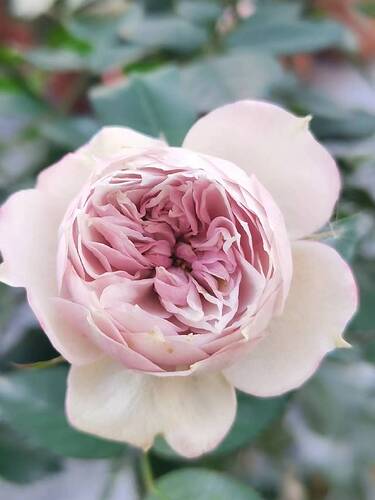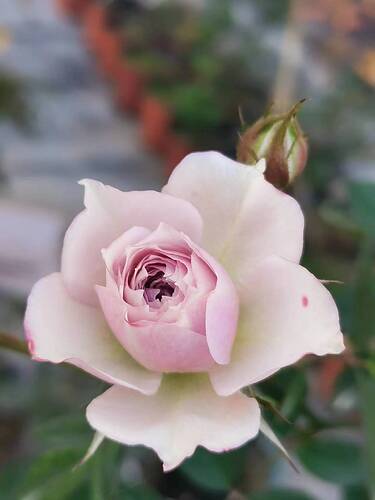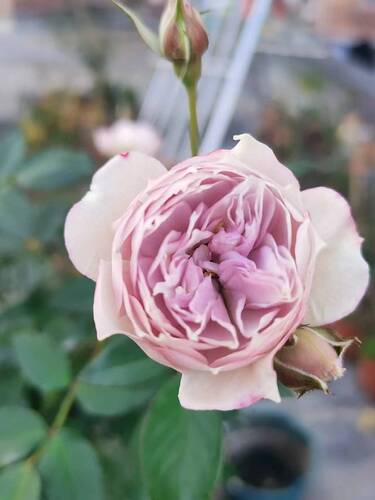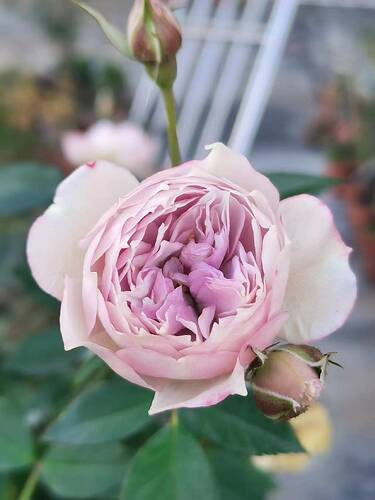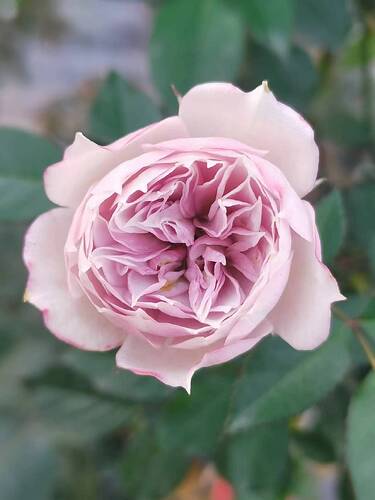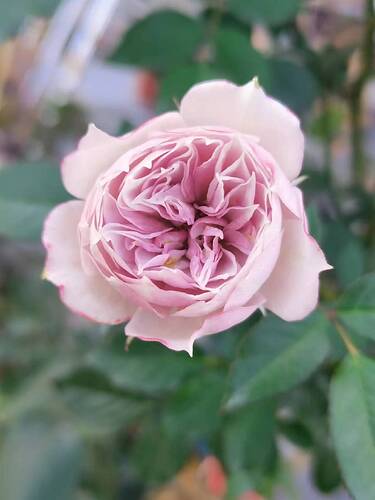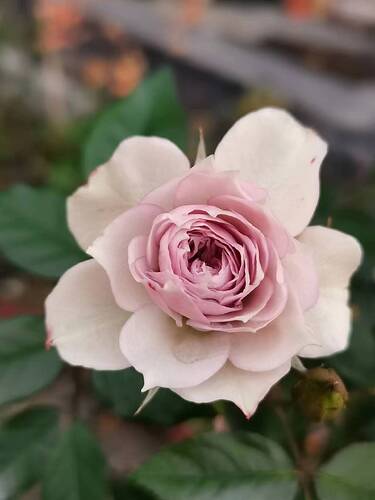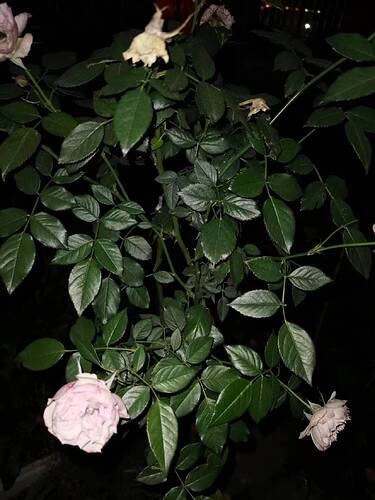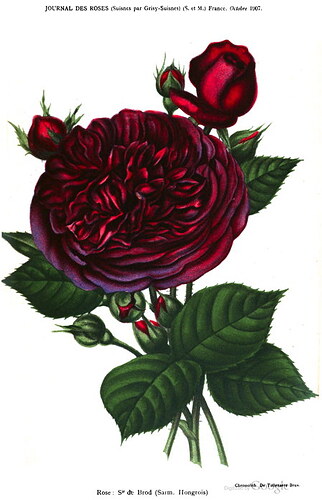This is a hybrid rose sent to me by a good friend of mine. It is low, light tea fragrance, and frequent flowers. Its petals will turn over in summer, and it is not resistant to black spot. This tree I grafted may look disease-resistant.Without the participation of Austin Rose
What communication problems, you can leave a message, I like the blue-purple
Have you tried Moore’s ‘Mr. Bluebird’? It is a semi-Mini raised from Parsons’ Pink x self (allegedly).
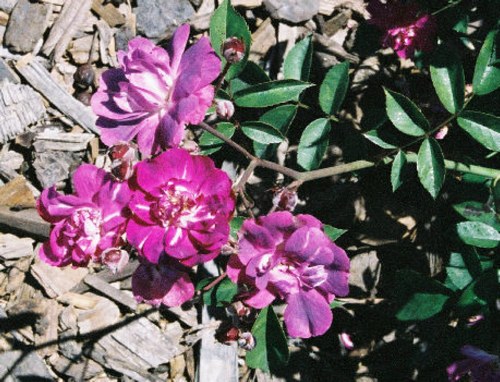
It is suspiciously similar to:
Roses; Or, A Monograph of the Genus Rosa - Volume 2 (1828)
Henry Charles Andrews
R. indica purpurea Andrews
The purple variety is said to have been first imported from China about the year 1810, to the gardens of Lord Milford, under the appellation of the Blue Rose; and as such many of them were sold at a guinea each, although the plant had not then flowered: such is the fascinating force of novelty, which even in embryo has the power to charm. This rose of expectation, when its blooms unfolded, no heavenly blue disclosed, but a red purple, which as it faded off became much paler, less brilliant, but of a bluer or colder purple, which gives to the fresh opened blossoms a very different appearance contrasted with those retiring; and although the blue’s celestial tint is wanting, it is nevertheless a graceful and very abundant flowering Rose. Our figure was made from plants in the nursery of Messrs. Colville.
http://bulbnrose.x10.mx/Roses/Rose_Pictures/Rosa/R_indicapurpAndr.html
Possibly another self-seedling from Old Blush.
It seems like a good idea to back-cross ‘Mr Bluebird’ to Old Blush.
BTW, ‘Mr. Bluebird’ x self gave a seedling that was the same, but even smaller.
I have long suspected that ‘Mr. Bluebird’ is not simply a selfing of “Old Blush”, but a cross of “Old Blush” and one of the purple Ramblers Moore had at the nursery, possibly ‘Violette’, which he often used in breeding. Its entirely possible considering the many thousands of blooms Ralph pollinated every year that some random pollinations would occur with other roses on the property.
The Polyantha-like growth habit of ‘Mr. Bluebird’ is certainly something that could have come from “Old Blush” X ‘Violette’, IMO.
Sorry, I don’t have this rose variety. It looks like the Rosa multiflora gene. It may be the same rose lineage as Sweet Chariot. If you want to increase the saturation of blue, I think it should be the lineage of a blue rose carrying Grey Pearl and Blue For You. Someone has replied to you in the post downstairs, you can take a look
I also believe that the results of self pollination cannot be so different. It must be that the roses have cheated.
I disagree about there being any “cheating” going on following selfing. ‘Old Blush’ is of hybrid origin, and (as I recall) exhibits “hybridity” (weakened pairing of chromosomes during meiosis). Moore also raised other Minis from OB x selfed, and was not the first person to do that. And let’s recall that the ‘Bengale Cent-feuilles’ was derived from our OB with no outside assistance.
http://bulbnrose.x10.mx/Roses/Rose_Pictures/B/BengaleCentfeuilles.html
The Tea-scented China also gave an interesting assortment of self-seedlings. The Yellow Tea-scented was the best known. It apparently traded perfume for color. There was a Fragrantissima that was lilac-pink with more perfume. Doubles, singles and other shades were known, long ago, but were mostly knocked off the market after the Yellow Noisette (raised from the Yellow Tea-scented) added vigor to the new Tea Rose class.
Selfing was all too common. That’s one reason rose lovers were so anxious to cross the Centifolias with Gallicas and Damasks for increased vigor.
BTW, Joseph Knight of the Exotic Nursery raised a series of self-seedlings from the Crimson China. These were much alike, but differed enough from each other to be useful in formal plantings.
But back to the original topic:
Eric,
There are at least three or four types of “blue” in roses. Probably more. They differ in their chemistry, as well as in their behavior (response to environmental conditions). Some are more pronounced in cool weather, other in heat and full sun. Some, like the rosacyanins in ‘Grey Pearl’, ‘Sterling Silver’, etc. are very stable with little regards to soil or weather. But when yellow pigments get involved … some very interesting effects result.
Café Olé


Lavender Pinocchio
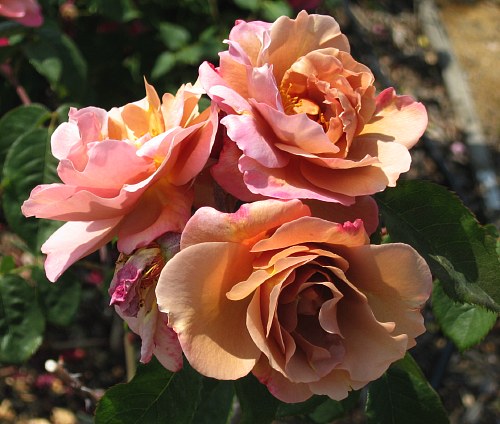
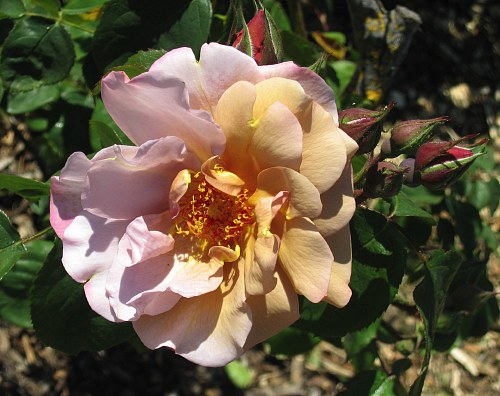
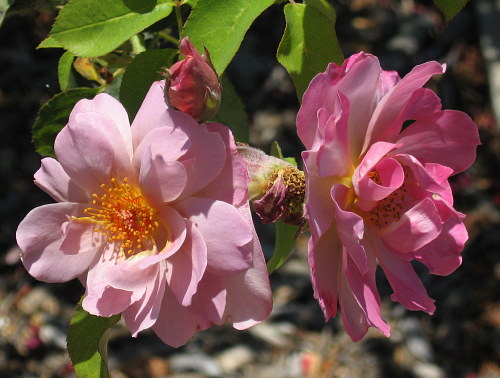
One possibility that has not been exploited (so far as I know) is the rosacyanin group derived from pelargonidin. Stoddard (1980) crossed Orangeade x Angel Face. One of the offspring was soft grey edged in orange. This is not only novel, if combined with some yellow coloring, it might give some attractive “autumn” shades of orange and tan.
http://bulbnrose.x10.mx/Roses/breeding/StoddardOrangeade1980.html
AVIs (Anthocyanic vacuolar inclusions) are a very different type, but variable.
The Bishop / L’Evêque
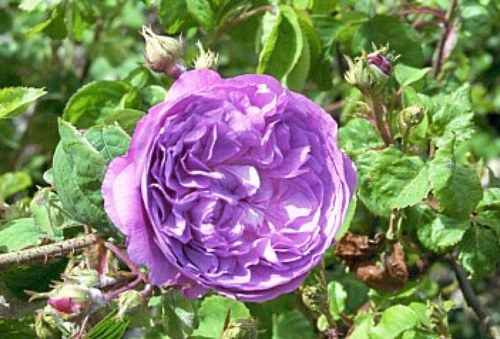
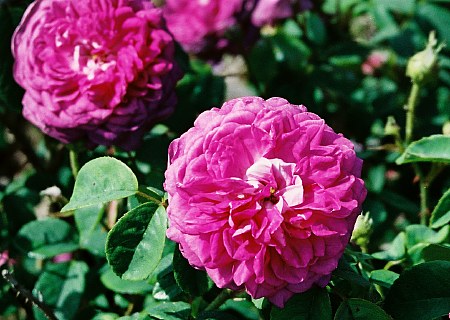
‘Rhapsody in Blue’ is another example, but I don’t have pics of it. It is worth nothing that this variety is derived in part from ‘Violacea’ a Gallica. Thus, the color in both this one and ‘The Bishop’ probably descend from the Tuscan/Velvet Rose group.
Then comes the co-pigment group.
Die Hybridation und Sämlingszucht der Rosen, p 11 (1864) 1997 (reprint)
By Rudolf Geschwind
In not too dry summer and soil the large, densely filled, flat flower is almost purplish-blue or violet-blue, usually with a dark red heart, and it is the only rose in this color that sometimes approaches a true blue, it surpasses Reine des Violettes, Violacea, Dr. Hogg and others of similar color. Viewed a few meters away, sometimes an especially dark colored flower appears almost black.
Journal of Genetics, 32: 127 (1936)
A Biochemical Survey of Factors for Flower Colour
Rose Scott-Montcrieff
Complex anthocyanins occur more often in nature than might be supposed from the results of isolation and identification. … The most interesting case recorded is that of the rose “Veilchenblau”, which appeared to develop less blue-red flowers in the very dry 1934 season than normally. The bluer petals were separated and found to contain complex as well as normal 3-5-dimonoside, while the redder petals contained less of the complex pigment.
Veilchenblau
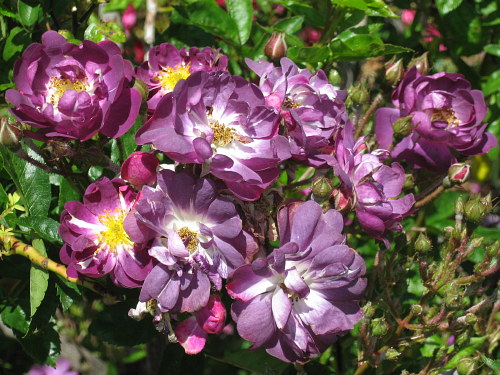
Baby Faurax on a bad day
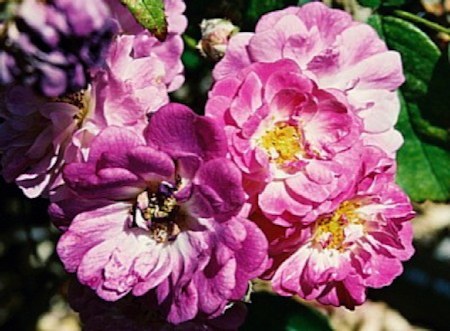
In cool, damp weather
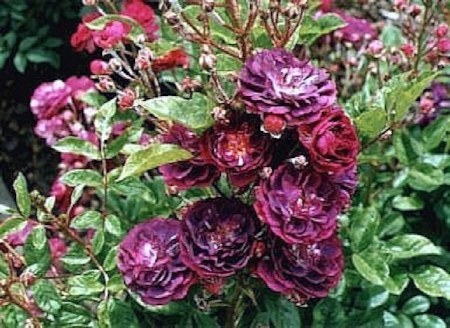
Sweet Chariot
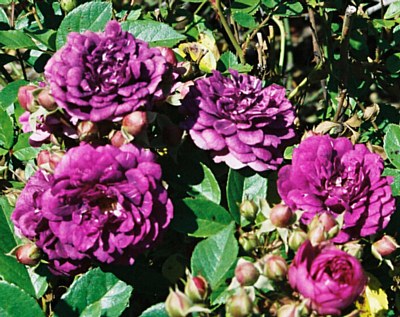
Same plant, different weather
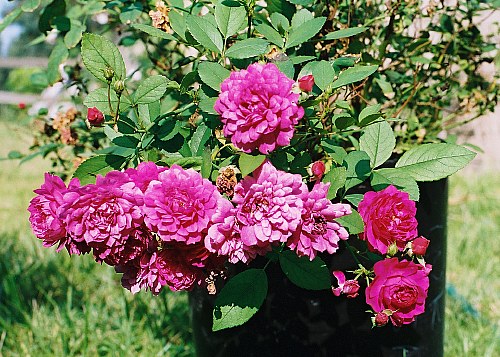
Perhaps dry soil and heat inhibit the uptake of the necessary calcium and iron ions. (I’m just guessing)
To the contrary, some derivatives of ‘Old Blush’ seem to blue more in heat and full sun. ‘Old Blush’ itself is a fresh, clear pink in cool weather or when grown in shade. But the color is dulled by a faint purple tint in summer.
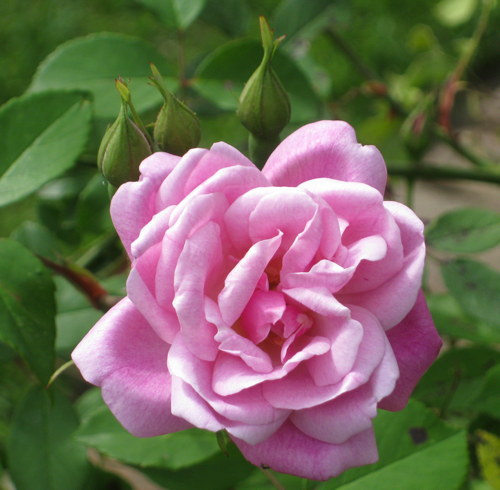
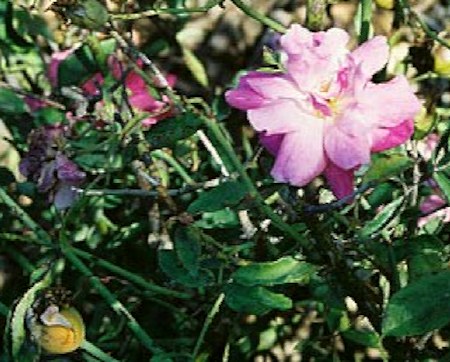
‘Margo Koster’ is also dull in the summer, and more brightly colored in the late autumn or allowed to open in darkness. Here is a more dramatic example of this color shift.
Golden Salmon
May 23, 2009
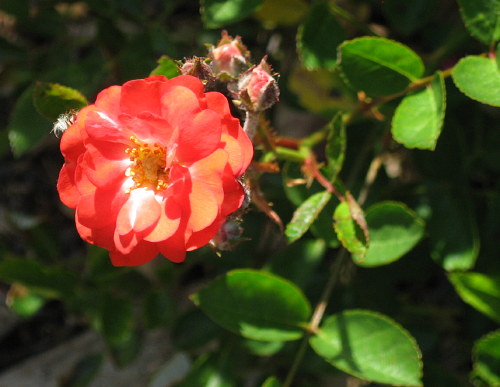
Aug 7, 2000 (Same plant)
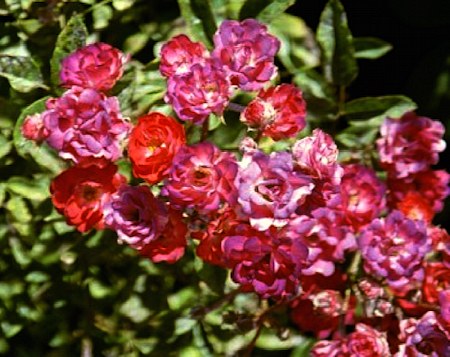
I’m still puzzling over the “bluing” of a flower presumably colored by pelargonidin … unless the (mutant) enzyme that mostly fails to convert dihydrokaempferol to dihydroquercetin is more active in hot weather than in cool.
And while we’re on the subject, consider ‘Basye’s Purple’. The color is variable, but generally dark, velvety and ranging fro maroon to violet. Like some other Rugosa derivatives, it can suffer from chlorosis when the pH isn’t right.
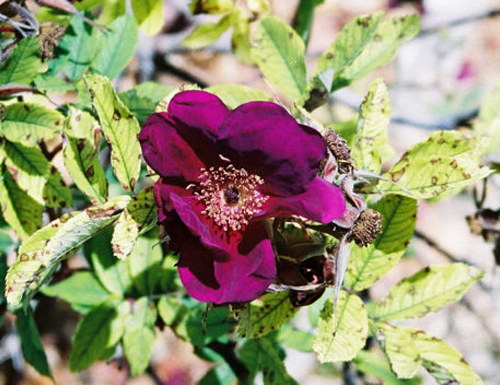
http://bulbnrose.x10.mx/Roses/Rose_Pictures/B/basyespurple.html
More info on pigments in Roses and other plants.
http://bulbnrose.x10.mx/KKing/RosePigments/RosePigments.html
